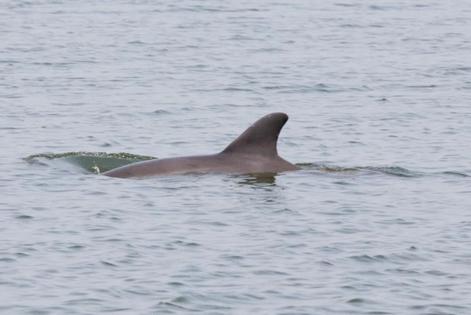Dolphins starve when seagrass dies off in Florida, study finds
Published in News & Features
ORLANDO, Fla. — Manatees are not the only marine mammals that suffer when seagrass dies off in Florida.
A new study found that dolphins in the Indian River Lagoon starved when seagrass meadows declined as well.
Researchers from the University of South Florida and the University of Central Florida analyzed tooth and tissue samples from stranded dolphins in the Lagoon over decades, from 1993 to 2013, and found that their diet shifted following algae blooms that killed off seagrass.
Not only did their diet shift to less nutritious prey, their death rates due to malnutrition spiked as well.
Less seagrass means fewer fish, and thus less food for dolphins. Seagrass provided habitat for myriad marine species, from shrimp to pinfish to ladyfish. Essentially, the dolphins had fewer species to eat, and the prey that remained was not as nourishing.
The chemical analysis of the stranded dolphins in the study showed that the Lagoon dolphins ate a lower proportion of ladyfish (a high energy snack) and a higher proportion of sea bream (a species with lower energy density) after a 2011 algae bloom and ensuing seagrass die-off.
The dolphin diet shift correlated with fewer ladyfish being caught by people, and more sea bream.
Between 2000 and 2020, the authors said malnutrition caused 17% of all recorded dolphin deaths. In 2013, after an algae bloom and ensuing seagrass die-off that began in 2011, that percentage skyrocketed to 61%.
Hypothetically, dolphins could migrate to an area with more food, but typically, they don’t venture out of their home territory, so merely traveling to a new estuary, or offshore, was likely not an option.
Other studies looked at 377 free-swimming dolphins in the estuary in 2013 and found that 64% were underweight and 5% were emaciated.
Seagrass die-offs in Florida often occur when nutrient pollution (phosphorus and nitrogen) flows into estuaries from farms, golf courses, street water and septic seepage. Those nutrients then fuel algae blooms that choke out seagrass, both by blocking sunlight and outcompeting the grass for oxygen at night.
As seagrass dies off, estuaries often become more murky, killing off even more grass. The process undercuts the inshore food chain that resident dolphins rely on. Biscayne Bay, the Indian River Lagoon and Tampa Bay have all suffered seagrass die-offs, particularly since 2011.
Manatee deaths spiked in the Indian River Lagoon in the winters of 2020 and 2021. The state recorded 1,052 manatee mortalities in 2021, significantly higher than the past five-year average of 682, and many were due to malnutrition.
Some areas of the Indian River Lagoon have seen seagrass make a comeback. As a result, the U.S. Fish and Wildlife Service declared the manatee unusual mortality event over in March of this year.
Gov. Ron DeSantis’s administration recently pledged $100 million to the Indian River Lagoon Protection Program, which aims to upgrade septic-to-sewer conversions and cut back on stormwater runoff. The Nature Conservancy Florida also is funding technology that aims to reduce runoff from urban areas including housing developments.
---------
©2025 Orlando Sentinel. Visit at orlandosentinel.com. Distributed by Tribune Content Agency, LLC.







Comments